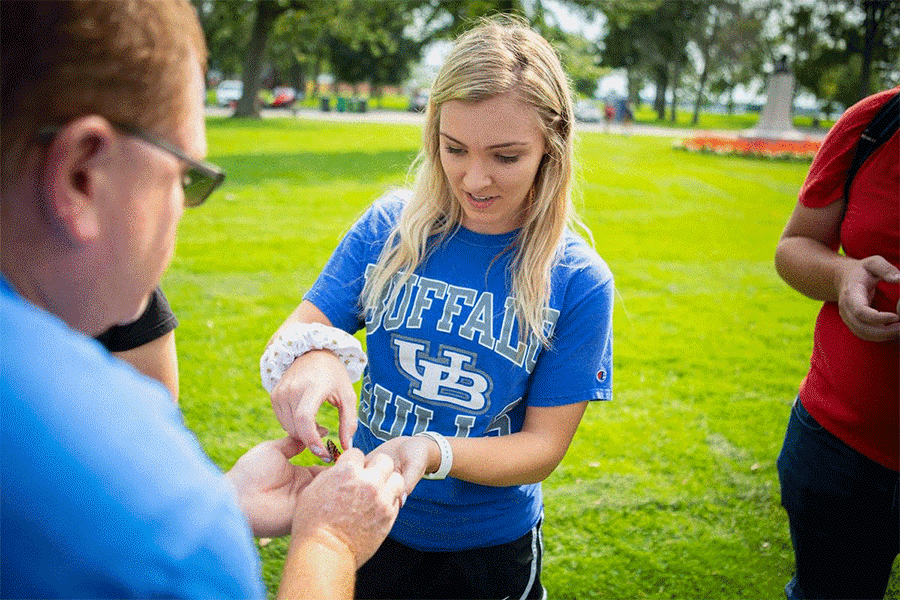Research News
UB students tag butterflies to help track the insects’ spectacular migration
Photos: Douglas Levere
By CHARLOTTE HSU
Published September 16, 2019 This content is archived.
On a warm September day, small groups of UB students walked through Riverside Park in Buffalo.
They moved slowly, peering through the branches and foliage of shrubs. In their hands, they carried insect nets — long, flowing cones of white mesh hanging from poles.
The teams were looking for a flash of orange, a flutter of wings. They were hoping to catch a butterfly, a monarch, to be precise.
The activity, part of UB’s Ecological Methods class, provided hands-on experience in conducting science while also promoting conservation. After capturing a butterfly, the class would tag it, placing a small sticker on the wing from Monarch Watch, a program that monitors the species’ spectacular migration.
As Nicholas Henshue, a clinical assistant professor in the College of Arts and Sciences’ new Department of Environment and Sustainability, explains, “They send us serialized plastic tiny stickers that we place on the monarch’s wings. The stickers are then recovered from the butterflies when they arrive at their overwintering grounds in central Mexico, or later on the next spring from butterflies that make it back to the United States.”
“They’ll be able to look at the tag and know they came from Riverside Park, right here in Buffalo,” Henshue says. “In the spring, butterflies born in Mexico that make it back to the United States can also be tracked using this method.”
He chose Riverside Park for the butterfly exercise because the Buffalo Olmsted Parks Conservancy has filled the park with native plants — such as common milkweed (Asclepias syriaca), maple-leaf viburnum (Viburnum acerifolium) and smooth Solomon’s seal (Polygonatum biflorum) — that attract pollinators.
That, paired with the park’s location along a narrow part of the Niagara River, make the area an ideal spot for monarchs migrating south from Canada to stop and rest.
“They really went out of their way to plant native pollinator-attracting plants in Riverside Park,” Henshue says. “The plantings were not as flashy or colorful as a non-native garden would have been, but the work paid off in spades, since the gardens are full of all sorts of native pollinators, butterflies and insects.”
In all, Henshue’s class tagged and released 15 monarchs over the course of several days in mid-September.

UB student Cassandra Rivier looks surprised as a butterfly takes flight from her hand. Photo: Douglas Levere
Experiential learning with monarch butterflies
For students, the class presented a chance to get out of the classroom and learn in the field. In addition to searching for monarchs, students also surveyed milkweed plants, counting the number of monarch eggs and caterpillar forms, called instars, found on the leaves. The plants serve as food for the larvae.
“What’s cool about this is it’s a lab that’s hands-on, where you get to go outside,” said Cassandra Rivier, a junior in environmental geosciences. “We’re doing science and using techniques that scientists actually use.”
“Getting out of the classroom is the best,” said Sadie Kratt, a senior in environmental geosciences and the Student Association’s assistant director of environmental affairs. “I strongly believe experiential learning is the best way to apply your skills and walk away feeling like you learned something. We focus on the methods part of ecology, which gives us useful skills to take to many different job fields.”
“Biodiversity loss is a negative effect of climate change, and we see more and more of it every day,” she adds. “Sustaining these species and preventing loss is one way to create a ‘sustainable world.’ By tagging monarchs and tracking their migration patterns, we can tell if the population is declining, and then take action.”
Watching and waiting — it’s all part of being a scientist
Kratt netted one of the first monarchs of the day, an experience that brought her back to her childhood in a rural area of Upstate New York, where she used to catch butterflies with her family as a kid.
Much of the day was not as exciting, though.
The students, teaching assistants and Henshue spent a lot of time wandering the park, eyes peeled, without much luck. Many minutes would pass without a monarch in sight. At one point, environmental geosciences student Lincoln Backman-Lowe captured a butterfly with a swoop of his net, only for the insect to find an escape route and fly out at the next moment.
And that’s part of science as well.
“If you’re doing an observational study of an animal in the wild, you may be working with an animal that covers a lot of ground within a day,” says Patrick Sysiong, a master’s student in evolution, ecology and behavior and teaching assistant in the class. "They may have a regular spot where they rest or look for food, but that doesn't mean they'll be there every day."
Henshue — who was earlier admiring photos that a colleague took of monarchs hanging in droves from trees at Times Beach, just a few miles away — put it this way: “It’s a natural phenomenon. They’re butterflies. They don’t care what we’re doing — they’re going to go where they want to be.”









